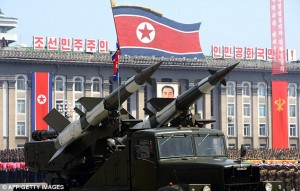There are two narratives on the Syria conflict rising to the top of the headlines the past few days. First, the ceasefire brokered by UN envoy Kofi Annan has failed. Second, Western powers are eager to escalate their interventionist policies. Both narratives are premature, I think.
Yes, considerable violence has continued despite the ceasefire. But overall, the violence seems to have decreased compared to before the ceasefire. Those in Washington thirsting for a comprehensive military intervention like Senators John McCain and Joe Lieberman pushed this “ceasefire failed” narrative mere days after it was announced, eager to pretend Washington has no other choice but war.
And it’s true that Western powers, particularly the U.S., Britian and France, are increasingly hinting at some sort of imminent intervention. The Obama administration is allegedly considering what actions it could take beyond the “non-lethal” aid already being sent to the opposition forces and the French Foreign Minister expressed intentions to push for war at the UN Security Council. But the inability for even people like McCain and Lieberman to put forth the “greeted as liberators” and “piece of cake” justifications for military action is indicative of the general understanding that intervening in Syria would be very costly for the U.S. (not to mention Syrians).
Marc Lynch of George Washington University has been one of the leading voices against direct intervention in Syria, as I wrote about here. Yesterday he gave a testimony to before the House Committee on Foreign Affairs Subcommittee on the Middle East and South Asia on what U.S. policy towards Syria should be. He eloquently reiterated his opposition to the the perilous proposals to intervene.
Nobody expects the current diplomatic path to quickly or easily end the conflict in Syria, but military intervention does not offer a compelling alternative. There are no cheap or easy forms of military intervention which would quickly bring down the regime of Bashar al-Assad or effectively protect Syrian civilians. Military half-measures, including safe zones, humanitarian corridors and arming the Syrian opposition, would likely spread the violence and increase the numbers of Syrian dead without increasing the likelihood of regime collapse. An initially limited intervention would most likely pave the way to more direct and expensive involvement comparable to the experience in Iraq.
He goes into details for each one of those points, but I especially want to draw attention to his analysis of launching an air campaign against the Assad regime. With whitewashed memories of Libya still crisp in people’s minds, bombing from the sky tends to strike people as foolproof. But Lynch points out that this would “likely begin with significant initial air strikes to eliminate air defenses,” but that “many Syrian anti-aircraft capabilities are located in or near urban areas, which means that significant civilian casualties could result from any attempt to eliminate them.” And that’s not all: there are important precedents for why “air power” and enforced “safe zones” would fail.
Using air power to protect civilians and defend the opposition within safe areas or humanitarian corridors is even more complex. Such safe areas could most easily be established and protected along the Turkish border, but most of the threatened civilians live in other parts of Syria. Humanitarian corridors would be extremely difficult to protect, and could create a new refugee crisis if desperate civilians rush into designated safe zones or neighboring countries. Protecting either would require a serious commitment of resources. Declaring a safe area without defending it effectively would only repeat the painful mistakes of history. In Bosnia, thousands of people were murdered in Srebrenica and other designated safe areas when peacekeepers lacked the means to protect them. Even historical “successes” are sobering. Operation Provide Comfort, established in northern Iraq after 1991, was envisioned as a short-term crisis response, but turned into a 12-year commitment that ended only when the United States invaded Iraq in 2003. Creating and protecting a safe area in Syria would therefore require a significant and lengthy investment of troops and resources, and would not likely hasten Assad’s collapse.
Lynch thinks the Annan plan could successfully end the bloodshed, if allowed to run its course. This all depends on whether or not the warmongers win out, but as of right now, I don’t see full-on military intervention happening.
———————————————–
In reference to the McCain-Lieberman push to intervene, Lynch says “It is not enough to demonstrate that the cause of intervention is just,” because the intervention would have consequences directly counter to the supposed “humanitarian justification” touted by the hawks. What still fascinates me is how readily the hawks – particularly the leadership of the GOP – admit that a war on Syria would really be about eliminating Iran’s ally and gaining more control over the Middle East. I wrote about this back in February. It’s amazing, really. They’re not even embarrassed to sing their imperial dogma loud and clear.





